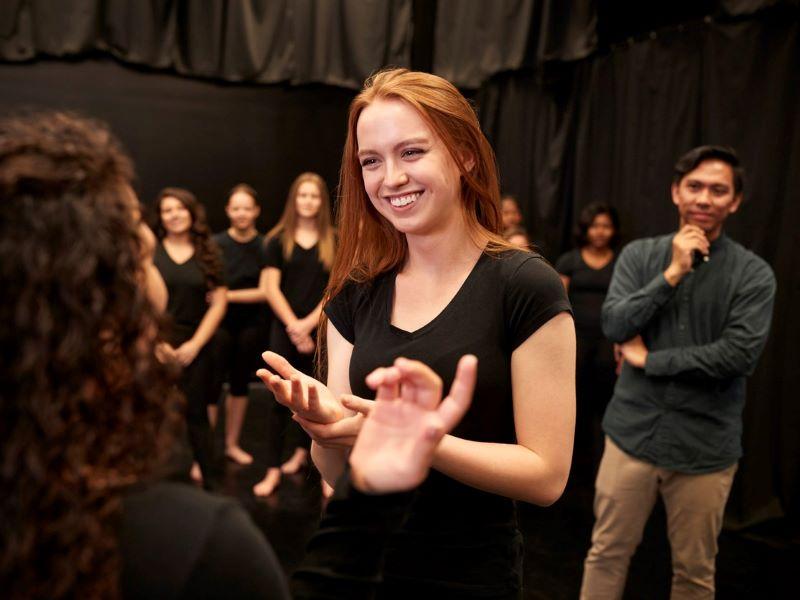Why drama?
Have you ever thought about how to use theatre icebreakers games in higher education? Drama activities such as games can promote teamwork, spontaneity, trust, creativity and confidence among students, and many of them can be adapted to work as icebreakers at the beginning of a lecture or class. Drama can bring play, humour and laughter to learning, which can improve motivation and reduce stress. Also, many drama activities can reduce stress by releasing mental, physical and emotional tension.
- Getting the quiet students to talk helps everyone
- Make virtual learning fun: using ‘break in’ rooms in online teaching
- Six tips on helping your students improve their teamwork skills
1. Name game
a) When participants are sitting: One begins the game – it is good if it is the teacher as this helps participants relax. Each participant stands up and calls out his or her name with a gesture. The activity is repeated, each person using a different gesture. The game goes like this until everyone is done. A further challenge is to call out the name in a different way (loud, whispering, singing, etc).
b) Circle name game: Participants form a circle and play the game as described above.
2. What makes me special
a) When participants are sitting: One participant begins to tell the other participants what makes him or her special in one short sentence – for example: What makes me special is that I speak four languages (everything you say has to be true). Then everyone that speaks four languages stands up and the one who started and speaks four languages has to invent something else to say that makes him or her special – for example: What makes me special is that I speak Chinese, English, Icelandic and German or What makes me special is that I am a twin. This repeats itself until no one responds and stands up, ie, no one shares this feature. The game goes on like this until everyone is done.
b) In a circle: Participants form a circle and play the game as above but when you have something in common with the one who just answered the question “What makes me special?” you walk towards that person and stand behind him or her.
3. Counting from one to 10
a) When participants are sitting: The participants are standing behind their seats and they are going to count from one to 10. Each number must only be said by one person. If anyone speaks at the same time as anyone else, everyone just starts again from one. If the group is big (20+) it’s possible to count to 20 or 30; this depends on the size of the group. When the group has managed to count from one to 10, without anyone doing it at the same time as someone else, the game is over.
b) Walking in a space: The participants find a space in the classroom. While playing the game above they walk around in the space.
4. Passing on the story or a word
This activity can be used either to create a story together or to create a story by each participant using only one word. One participant, or the teacher, starts the story or the word and then signals another participant that the storytelling role is being passed on to the next person, who then continues it.
Those who are not telling the story at the time simply listen until it is their turn to become the storyteller.
5. Talking to each other in pairs
This activity helps the participants to get to know each other. The participants conduct an interview with the person next to them. The basis of the interview could be: name, age, origin, place of residence, schooling, jobs in recent years, hobbies, studies, etc.
Each participant has five minutes to ask the questions and then they switch.
After the interviews, they introduce each other to the whole class with:
This is (name), he/she is (age), he/she lives...
Try to keep it paperless and really introduce your interviewee, highlighting what you find most interesting.
6. The cross and circle
This exercise looks easy to do, but it is extremely difficult to achieve in practice. The participants can play this game sitting down or standing up. The participants are asked to draw a large or small circle with their right hand. It is easy and everybody can do it. Then ask them to drop their hand and make a cross with their left hand. This is also easy and everybody can do it. Then stop. Now you ask them to do both at the same time. This is almost impossible.
By using drama activities, the teacher can help students to overcome shyness and reduce stress in the beginning of their studies in higher education. Drama activities can also help students to be more flexible and open to other students and their ideas.
Jóna Guðrún Jónsdóttir is an adjunct in drama and theatre education and Rannveig Björk Thorkelsdóttir is an associate professor in drama and theatre education at the School of Education, University of Iceland.
If you found this interesting and want advice and insight from academics and university staff delivered direct to your inbox each week, sign up for the THE Campus newsletter.




comment